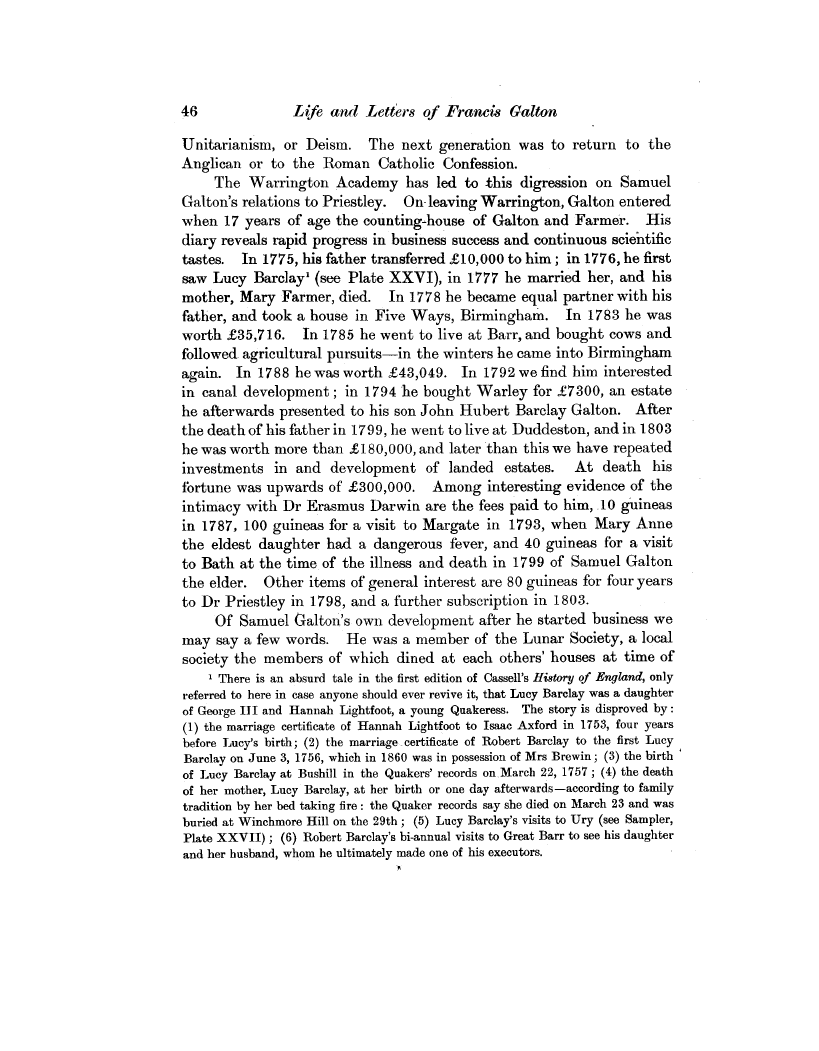| ||||||

OCR Rendition - approximate
46 Life and Letters of Francis Galton Unitarianism, or Deism. The next generation was to return to the Anglican or to the Roman Catholic Confession. The Warrington Academy has led to this digression on Samuel Galton's relations to Priestley. On- leaving Warrington, Galton entered when 17 years of age the counting-house of Galton and Farmer. His diary reveals rapid progress in business success and continuous scientific tastes. In 1775, his father transferred £10,000 to him ; in 1776, he first saw Lucy Barclay' (see Plate XXVI), in 1777 he married her, and his mother, Mary Farmer, died. In 1778 he became equal partner with his father, and took a house in Five Ways, Birmingham. In 1783 he was worth £35,716. In 1785 he went to live at Barr, and bought cows and followed. agricultural pursuits-in the winters he came into Birmingham again. In 1788 he was worth £43,049. In 1792 we find him interested in canal development ; in 1794 he bought Warley for £7300, an estate he afterwards presented to his son John Hubert Barclay Galton. After the death of his father in 1799, he went to live at Duddeston, and in 1803 he was worth more than £180,000, and later than this we have repeated investments in and development of landed estates. At death his fortune was upwards of £300,000. Among interesting evidence of the intimacy with Dr Erasmus Darwin are the fees paid to him,.10 guineas in 1787, 100 guineas for a visit to Margate in 1793, when Mary Anne the eldest daughter had a dangerous fever, and 40 guineas for a visit to Bath at the time of the illness and death in 1799 of Samuel Galton the elder. Other items of general interest are 80 guineas for four years to Dr Priestley in 1798, and a further subscription in 1803. Of Samuel Galton's own development after he started business we may say a few words. He was a member of the Lunar Society, a local society the members of which dined at each others' houses at time of 1 There is an absurd tale in the first edition of Cassell's History of England, only referred to here in case anyone should ever revive it, that Lucy Barclay was a daughter of George III and Hannah Lightfoot, a young Quakeress. The story is disproved by (1) the marriage certificate of Hannah Lightfoot to Isaac Axford in 1753, four years before Lucy's birth; (2) the marriage _certificate of Robert Barclay to the first Lucy Barclay on June 3, 1756, which in 1860 was in possession of Mrs Brewin; (3) the birth ' of Lucy Barclay at Bushill in the Quakers' records on. March 22, 1757; (4) the death of her mother, Lucy Barclay, at her birth or one day afterwards-according to family tradition by her bed taking fire : the Quaker records say she died on March 23 and was buried at Winchmore Hill on the 29th; (5) Lucy Barclay's visits to Ury (see Sampler, Plate XXVII) ; (6) Robert Barclay's bi-annual visits to Great Barr to see his daughter and her husband, whom he ultimately made one of his executors. R
|